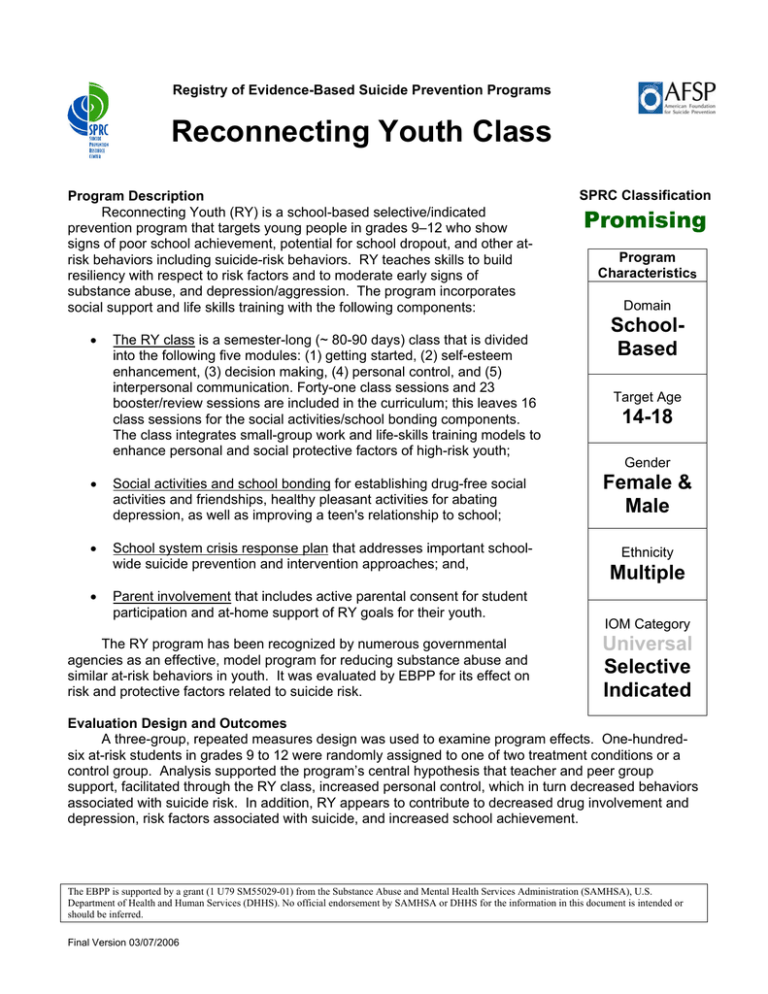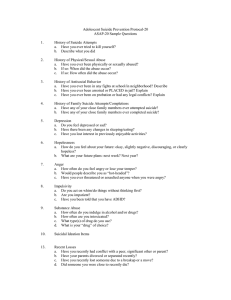Reconnecting Youth Class Promising
advertisement

Registry of Evidence-Based Suicide Prevention Programs Reconnecting Youth Class Program Description Reconnecting Youth (RY) is a school-based selective/indicated prevention program that targets young people in grades 9–12 who show signs of poor school achievement, potential for school dropout, and other atrisk behaviors including suicide-risk behaviors. RY teaches skills to build resiliency with respect to risk factors and to moderate early signs of substance abuse, and depression/aggression. The program incorporates social support and life skills training with the following components: • The RY class is a semester-long (~ 80-90 days) class that is divided into the following five modules: (1) getting started, (2) self-esteem enhancement, (3) decision making, (4) personal control, and (5) interpersonal communication. Forty-one class sessions and 23 booster/review sessions are included in the curriculum; this leaves 16 class sessions for the social activities/school bonding components. The class integrates small-group work and life-skills training models to enhance personal and social protective factors of high-risk youth; SPRC Classification Promising Program Characteristics Domain SchoolBased Target Age 14-18 Gender • Social activities and school bonding for establishing drug-free social activities and friendships, healthy pleasant activities for abating depression, as well as improving a teen's relationship to school; Female & Male • School system crisis response plan that addresses important schoolwide suicide prevention and intervention approaches; and, Ethnicity • Parent involvement that includes active parental consent for student participation and at-home support of RY goals for their youth. The RY program has been recognized by numerous governmental agencies as an effective, model program for reducing substance abuse and similar at-risk behaviors in youth. It was evaluated by EBPP for its effect on risk and protective factors related to suicide risk. Multiple IOM Category Universal Selective Indicated Evaluation Design and Outcomes A three-group, repeated measures design was used to examine program effects. One-hundredsix at-risk students in grades 9 to 12 were randomly assigned to one of two treatment conditions or a control group. Analysis supported the program’s central hypothesis that teacher and peer group support, facilitated through the RY class, increased personal control, which in turn decreased behaviors associated with suicide risk. In addition, RY appears to contribute to decreased drug involvement and depression, risk factors associated with suicide, and increased school achievement. The EBPP is supported by a grant (1 U79 SM55029-01) from the Substance Abuse and Mental Health Services Administration (SAMHSA), U.S. Department of Health and Human Services (DHHS). No official endorsement by SAMHSA or DHHS for the information in this document is intended or should be inferred. Final Version 03/07/2006 Generalizability While the RY program was studied in six urban schools, it has been implemented in a variety of schools in both urban and suburban settings representing a cross section of ethnic enrollments. Implementation Essentials • • • • • • Identifying, recruiting and inviting RY students according to the RY design Small class size (1:10 teacher-to-student ratio), class taken for credit as a regular course in the student’s school schedule, providing at least 4,000 minutes of instruction and implemented as designed; no “rolling” admission into RY—i.e., no changes in enrollment after the first 1-2 wks. Teacher recruitment, selection and supervision/support as designed in the RY model RY training for teachers, program coordinators and school/community administrators Implementing the RY class and social activities/school bonding components with fidelity Follow-up consultation visits at 6-month periods (optional). Targeted Protective and Risk Factors The RY program impacts the following risk and protective factors that have been targeted by the National Strategy for Suicide Prevention for the reduction of suicide in the United States. Increased Protective Factors Decreased Risk Factors Strong connections to family and community support Skills in problem solving, conflict resolution, and nonviolent handling of disputes Alcohol and substance abuse disorders Mental disorders, particularly mood disorders, schizophrenia, anxiety disorders and certain personality disorders Impulsive and/or aggressive tendencies Relational or Social Loss Program Costs Curriculum Guide (2nd Edition).................................................................$299.95 (plus shipping & handling) Student Workbook (set of 10) ............................................................................................................ $211.95 Budget for Activities component/Transportation............................................................. ~ $450.00/RY Class Classroom supplies/copying costs/miscellaneous expenses ...............................................................varies Four days of RY teacher/program coordinator training (8 participants/trainer) .............................. $4,800.00 Additional one-day administrator/program coordinator training...................................................... $1,200.00 Trainer travel and expenses ................................................................................................................ Varies Additional expenses include: (1) RY teacher salary, (2) substitute salary, (3) supplemental salary for participation in RY training and ongoing supervision. Program Contact Information Program Information & Scheduling Beth McNamara, MSW Information and Training Coordinator Reconnecting Youth Co ™ Phone: 425-861-1177 Fax: 206-726-6049 Email: ry.info@verizon.net Program Publisher Solution Tree 304 West Kirkwood Avenue, Suite 2 Bloomington, IN 47404-5132 Phone: 800-733-6786 Fax: 812-336-7790 www.solution-tree.com/ References & Support Materials Eggert, L.L., Thompson, E.A., Herting, J.R., & Randell, B.P. (2001). Reconnecting youth to prevent drug abuse, school dropout, and suicidal behaviors among high-risk youth. In E. Wagner & H.B. Waldron (Eds.), Innovations in Adolescent Substance Abuse Intervention (pp. 51-84). Oxford: Elsevier Science. Eggert, L.L., Thompson, E.A., Herting, J.R., & Nicholas, L.J. (1995). Reducing suicide potential among high-risk youth: Tests of a school-based prevention program. Suicide and Life-Threatening Behavior, 25(2), 276296. Eggert, L.L. & Nicholas, L.J. (2004). Reconnecting Youth: A Peer Group Approach to Building Life Skills (2nd Edition). Bloomington, IN: National Educational Service. Thompson, E. A., Eggert, L. L., & Herting, J. R. (2000). Mediating effects of an indicated prevention program for reducing youth depression and suicide risk behaviors. Suicide and Life Threatening Behavior, 30(3), 252-271.




